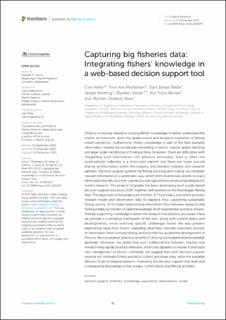| dc.contributor.author | Kelly, Cian | |
| dc.contributor.author | Michelsen, Finn Are | |
| dc.contributor.author | Reite, Karl Johan | |
| dc.contributor.author | Kolding, Jeppe | |
| dc.contributor.author | Varpe, Øystein | |
| dc.contributor.author | Prytz Berset, Are | |
| dc.contributor.author | Alver, Morten | |
| dc.date.accessioned | 2023-01-03T09:18:59Z | |
| dc.date.available | 2023-01-03T09:18:59Z | |
| dc.date.created | 2022-12-12T12:22:40Z | |
| dc.date.issued | 2022 | |
| dc.identifier.citation | Frontiers in Marine Science. 2022, 9 1-11. | en_US |
| dc.identifier.issn | 2296-7745 | |
| dc.identifier.uri | https://hdl.handle.net/11250/3040497 | |
| dc.description.abstract | There is increasing interest in utilizing fishers’ knowledge to better understand the marine environment, given the spatial extent and temporal resolution of fishing vessel operations. Furthermore, fishers’ knowledge is part of the best available information needed for sustainable harvesting of stocks, marine spatial planning and large-scale monitoring of fishing activity. However, there are difficulties with integrating such information into advisory processes. Data is often not systematically collected in a structured manner and there are issues around sharing of information within the industry, and between industry and research partners. Decision support systems for fishing planning and routing can integrate relevant information in a systematic way, which both incentivizes vessels to share information beneficial to their operations and capture time sensitive big datasets for marine research. The project Fishguider has been developing such a web-based decision support tool since 2019, together with partners in the Norwegian fishing fleet. The objectives of the project are twofold: 1) To provide a tool which provides relevant model and observation data to skippers, thus supporting sustainable fishing activity. 2) To foster bidirectional information flow between research and fishing activity by transfer of salient knowledge (both experiential and data-driven), thereby supporting knowledge creation for research and advisory processes. Here we provide a conceptual framework of the tool, along with current status and developments, while outlining specific challenges faced. We also present experiential input from fishers’ regarding what they consider important sources of information when actively fishing, and how this has guided the development of the tool. We also explore potential benefits of utilizing such experiential knowledge generally. Moreover, we detail how such collaborations between industry and research may rapidly produce extensive, structured datasets for research and input into management of stocks. Ultimately, we suggest that such decision support services will motivate fishing vessels to collect and share data, while the available data will foster increased research, improving the decision support tool itself and consequently knowledge of the oceans, its fish stocks and fishing activities. | en_US |
| dc.language.iso | eng | en_US |
| dc.publisher | Frontiers | en_US |
| dc.rights | Navngivelse 4.0 Internasjonal | * |
| dc.rights.uri | http://creativecommons.org/licenses/by/4.0/deed.no | * |
| dc.subject | model | en_US |
| dc.subject | observations | en_US |
| dc.subject | experience | en_US |
| dc.subject | knowledge | en_US |
| dc.subject | interface | en_US |
| dc.subject | decision support | en_US |
| dc.title | Capturing big fisheries data: Integrating fishers’ knowledge in a web-based decision support tool | en_US |
| dc.title.alternative | Capturing big fisheries data: Integrating fishers’ knowledge in a web-based decision support tool | en_US |
| dc.type | Peer reviewed | en_US |
| dc.type | Journal article | en_US |
| dc.description.version | publishedVersion | en_US |
| dc.rights.holder | © 2022 Kelly, Michelsen, Reite, Kolding, Varpe, Berset and Alver. This is an openaccess article distributed under the terms of the Creative Commons Attribution License (CC BY). The use, distribution or reproduction in other forums is permitted, provided the original author(s) and the copyright owner(s) are credited and that the original publication in this journal is cited, in accordance with accepted academic practice. No use, distribution or reproduction is permitted which does not comply with these terms. | en_US |
| dc.source.pagenumber | 1-11 | en_US |
| dc.source.volume | 9 | en_US |
| dc.source.journal | Frontiers in Marine Science | en_US |
| dc.identifier.doi | 10.3389/fmars.2022.1051879 | |
| dc.identifier.cristin | 2091874 | |
| dc.relation.project | Norges forskningsråd: 296321 | en_US |
| cristin.ispublished | true | |
| cristin.fulltext | original | |
| cristin.qualitycode | 1 | |

